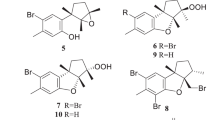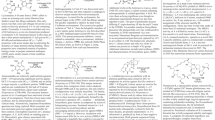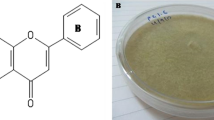Abstract
Marine-derived fungi have been shown in recent years to produce a plethora of new bioactive secondary metabolites, some of them featuring new carbon frameworks hitherto unprecedented in nature. These compounds are of interest as new lead structures for medicine as well as for plant protection. The aim of this protocol is to give a detailed description of methods useful for the isolation and cultivation of fungi associated with various marine organisms (sponges, algae and mangrove plants) for the extraction, characterization and structure elucidation of biologically active secondary metabolites produced by these marine-derived endophytic fungi, and for the preliminary evaluation of their pharmacological properties based on rapid 'in house' screening systems. Some results exemplifying the positive outcomes of the protocol are given at the end. From sampling in marine environment to completion of the structure elucidation and bioactivity screening, a period of at least 3 months has to be scheduled.
This is a preview of subscription content, access via your institution
Access options
Subscribe to this journal
Receive 12 print issues and online access
$259.00 per year
only $21.58 per issue
Buy this article
- Purchase on Springer Link
- Instant access to full article PDF
Prices may be subject to local taxes which are calculated during checkout






Similar content being viewed by others
References
Grove, J.F., MacMillan, J., Mulholland, T.P.C. & Rogers, M.A.T. Griseofulvin part I. J. Chem. Soc. 3949–3958 (1952).
Butler, M.S. The role of natural product chemistry in drug discovery. J. Nat. Prod. 67, 2141–2153 (2004).
Abramovits, W., Gupta, A. & Gover, M. Altabax (retapamulin ointment), 1%. Skinmed 6, 239–240 (2007).
Dewick, P.M. Makrolides and polyethers. in Medicinal Natural Products. A Biosynthetic Approach (John Wiley & Sons Ltd., Chichester, UK, 2006).
Balba, H. Review of strobilurine fungicide chemicals. J. Environ. Sci. Health B. 42, 441–445 (2007).
Bugni, T.S. & Ireland, C.M. Marine-derived fungi: a chemically and biologically diverse group of micro-organisms review. Nat. Prod. Rep. 21, 143–163 (2004).
König, G.M. et al. Natural products from marine organisms and their associated microbes. Chembiochem 7, 229–238 (2006).
Kohlmeyer, J. & Kohlmeyer, E. in Marine Mycology, the higher fungi (Academic Press, New York, San Francisco, London, 1979).
Schulz, B. In Bioactive Fungal Metabolites–Impact and Exploitation, 20 (British Mycological Society, International Symposium Proceedings: University of Wales, Swansea, UK, 2001).
Baker, D. & Alvi, K. Small-molecule natural products: new structures, new activities. Curr. Opin. Biotechnol. 15, 576–583 (2004).
Pietra, F. Secondary metabolites from marine microorganisms: bacteria, protozoa, algae and fungi. Achievements and prospects. Nat. Prod. Rep. 14, 453–464 (1997).
Blunt, J.W. et al. Marine natural products. Nat. Prod. Rep. 25, 35–94 (2008).
Faulkner, D.J. Highlights of marine natural products chemistry (1972–1999). Nat. Prod. Rep. 17, 1–6 (2000a).
Zhang, H.W., Song, Y.C. & Tan, R.X. Biology and chemistry of endophytes. Nat. Prod. Rep. 23, 753–771, Erratum 828–830 (2006).
Mayer, A. & Gustafson, K. Marine pharmacology in 2005–2006: antitumor and cytotoxic compounds. Eur. J. Cancer (2008).
Bernan, V.S., Greenstein, M. & Maiese, W.M. Marine microorganisms as a source of new natural products. Adv. Appl. Microbiol. 43, 57 (1997).
Höller, U. et al. Fungi from marine sponges: diversity, biological activity and secondary metabolites. Mycol. Res. 104, 1354–1365 (2000).
Jensen, P.R. & Fenical, W. Marine microorganisms and drug discovery: current status and future potential. In Drugs from the Sea (Karger Publishers, Basel, Switzerland) 6–29 (2000).
Jensen, P.R. & Fenical, W. Secondary metabolites from marine fungi. In Fungi in Marine Environments (ed. Hyde, K.D.) 293–315 (Fungal Diversity Press, Hong Kong, 2002).
Koenig, G.M. & Wright, A. D. trends in marine biotechnology. In Drug Discovery from Nature (eds. Grabley, S & Thiericke, R), (Springer-Verlag, Berlin) 180–187 (1999).
Verbist, J.F., Sallenave, C. & Pouchus, Y.F. Stud. Nat. Prod. Chem. 24, 979 (2000).
Ebel, R. Secondary metabolites from marine derived fungi. In Frontiers in Marine Biotechnology (eds. Proksch, P. & Müller, W.E.G.) 73–143 (Horizon Scientific Press, Norwich, UK, 2006).
Laatsch, H. Marine bacterial metabolites. In Frontiers in Marine Biotechnology (eds. Proksch, P. & Müller, W.E.G.) 225–288 (Horizon Scientific Press, Norwich, UK, 2006).
Gerwick, W. The secondary metabolites and biosynthetic gene clusters of marine cyanobacteria. In Frontiers in Marine Biotechnology (eds. Proksch, P. & Müller, W.E.G.) 179–224 (Horizon Scientific Press, Norwich, UK, 2006).
Shimizu, Y. & Li, B. Microalgae: special problems and methology. In Frontiers in Marine Biotechnology (eds. Proksch, P. & Müller, W.E.G.) 145–174 (Horizon Scientific Press, Norwich, UK, 2006).
Newton, G.G.F. & Abraham, E.P. Cephalosporine C, a new antibiotic containing sulphur and D-α-aminoadipic acid. Nature 175, 548 (1955).
Dalla Bona, A. et al. Synthesis, conformation, and bioactivity of novel analogues of the antiviral lipopeptide halovir A. J. Pept. Sci. 12, 748–757 (2006).
Bringmann, G. et al. Large-scale biotechnological production of the anti-leukemic marine natural product sorbicillactone A. Mar. Drugs 5, 23–30 (2007).
Blunt, J.W. et al. Marine natural products. Nat. Prod. Rep. 24, 31–86 (2007).
Jones, G.E.B., Stanley, S.J. & Pinruan, U. Marine endophyte sources of new chemical natural products: a review. Botanica Marina 51, 163–170 (2008).
Schulz, B. et al. Screening strategies for obtained novel, biologically active, fungal secondary metabolites from marine habitats. Botanica Marina 51, 219–234 (2008).
Brauers, G. et al. Anthraquinones and betaenone derivatives from the sponge-associated fungus Microsphaeropsis sp.: novel inhibitors of protein kinases. J. Nat. Prod. 63, 739–745 (2000).
Lin, W. et al. Novel chromone derivatives from the fungus Aspergillus versicolor isolated from the marine sponge Xestospongia exigua. J. Nat. Prod. 66, 57–61 (2003).
Hallermann, J., Berg, G. & Schulz, B. Isolation procedures for endophytic microorganisms. In Microbial Root Endophytes (Soil Biology) (eds. Schulz, B., Boyle, C. and Sieber, T.N.) 299–328 (Springer-Verlag, Berlin Heidelberg, 2006).
Klemke, C., Kehraus, S., Wright, A.D. & Koenig, G.M. New secondary metabolites from the marine endophytic fungus Apiospora montagnei. J. Nat. Prod. 67, 1058–1063 (2004).
Gao, Z., Li, B., Zheng, C. & Wang, G. Molecular detection of fungal communities in the Hawaiian marine sponges Suberites zeteki and Mycale armata. Appl. Environ. Microbiol. 74, 6091–6101 (2008).
Bode, H.B., Bethe, B., Höfs, R. & Zeeck, A. Big effects from small changes: possible ways to explore nature′s chemical diversity. Chembiochem 3, 619–627 (2002).
Aly, A.H. et al. Cytotoxic metabolites from the fungal endophyte Alternaria sp. and their subsequent detection in its host plant Polygonum senegalense. J. Nat. Prod. 71, 972–980 (2008).
Wang, S. et al. Chaetopyranin, a benzaldehyde derivative, and other related metabolites from Chaetomium globosum, an endophytic fungus derived from the marine red alga Polysiphonia urceolata. J. Nat. Prod. 69, 1622–1625 (2006).
Kjer, J. Xanalteric acids I and II and related phenolic compounds from an endophytic Alternaria sp. isolated from the mangrove plant Sonneratia alba. J. Nat. Prod. 72, 2053–2057 (2009).
Ebada, S.S., Edrada, R.A., Lin, W. & Proksch, P. Methods for isolation, purification and structural elucidation of bioactive secondary metabolites from marine invertebrates. Nat. Protoc. 3, 1820–1831 (2008).
Xu, J. et al. Cytosporones, coumarins, and an alkaloid from the endophytic fungus Pestalotiopsis sp. isolated from the Chinese mangrove plant Rhizophora mucronata. Bioorg. Med. Chem. 17, 7362–7367 (2009).
Jadulco, R. et al. New macrolides and furan carboxylic acid derivative from the sponge-derived fungus Cladosporium herbarum. J. Nat. Prod. 64, 527–530 (2001).
Proksch, P. et al. Sponge-associated fungi and their bioactive compounds: the Suberites case. Botanica Marina 51, 209–218 (2008).
Technische Regeln für biologische Arbeitsstoffe. TRBA 460: Einstufung von Pilzen in Risikogruppen. BArbBl. Heft 10, 78–84 (2002).
Sichere Biotechnologie. Classification of biological agents: fungi. Merkblatt B007e (2003).
Ashour, M. et al. Kahalalide derivatives from the Indian sacoglossan mollusk Elysia grandifolia. J. Nat. Prod. 69, 1547–1553 (2006).
Meyer, B.N. et al. Brine shrimp: a convenient general bioassay for active plant constituents. Planta Med. 45, 31 (1982).
Marfey, P. Determination of D-amino acids. Part II: use of a bifunctional reagent 1,5-difluoro-2,4-dinitrobenzene. Carlsberg Res. Commun. 49, 591–596 (1984).
Acknowledgements
We are indebted to numerous previous coworkers and to several colleagues who were indispensable for our studies on marine-derived fungi. Continued support by BMBF to P.P. is gratefully acknowledged.
Author information
Authors and Affiliations
Corresponding author
Rights and permissions
About this article
Cite this article
Kjer, J., Debbab, A., Aly, A. et al. Methods for isolation of marine-derived endophytic fungi and their bioactive secondary products. Nat Protoc 5, 479–490 (2010). https://doi.org/10.1038/nprot.2009.233
Published:
Issue Date:
DOI: https://doi.org/10.1038/nprot.2009.233
This article is cited by
-
The hidden diversity of mangrove endophytic fungi from Tanzania: insights from a preliminary study
Biologia (2024)
-
Paralemnalia thyrsoides-associated fungi: phylogenetic diversity, cytotoxic potential, metabolomic profiling and docking analysis
BMC Microbiology (2023)
-
Evaluation of the anti-infective potential of the seed endophytic fungi of Corchorus olitorius through metabolomics and molecular docking approach
BMC Microbiology (2023)
-
Mangrove-associated endomycota: diversity and functional significance as a source of novel drug leads
Archives of Microbiology (2023)
-
Characterization and antibacterial activity of endophytic fungi isolated from Avicennia marina
Vegetos (2023)
Comments
By submitting a comment you agree to abide by our Terms and Community Guidelines. If you find something abusive or that does not comply with our terms or guidelines please flag it as inappropriate.



